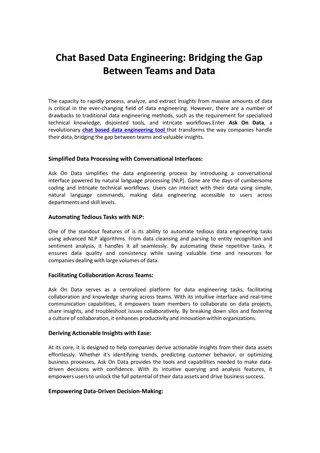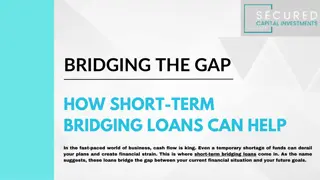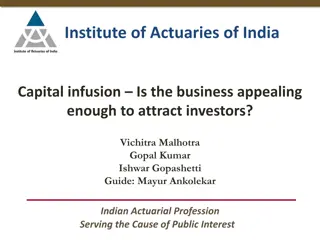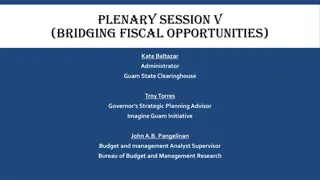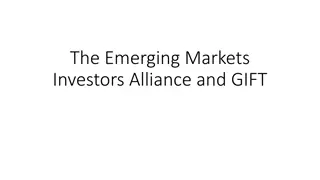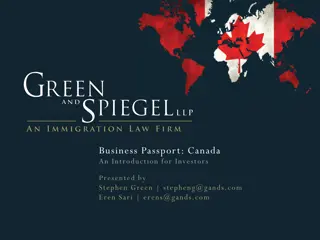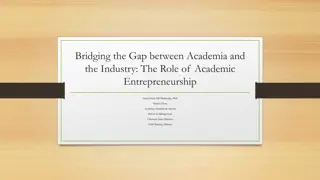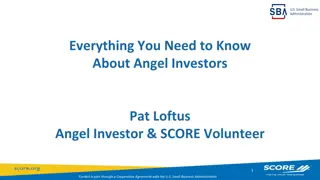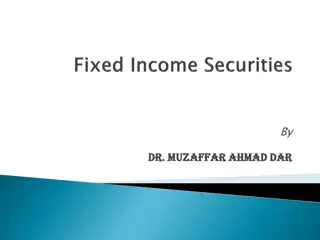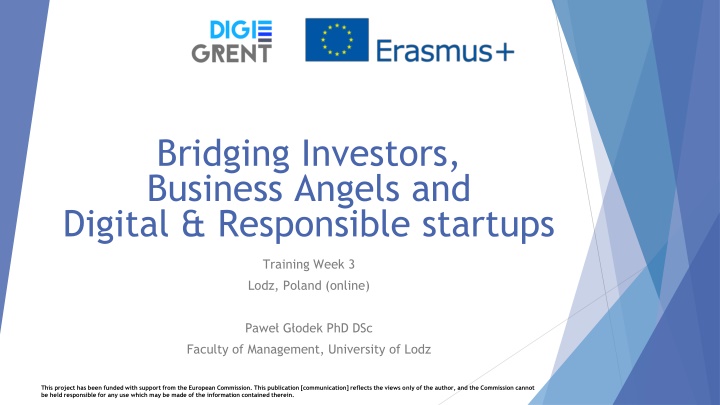
Bridging Investors and Startups: Financial Strategies and Partnerships
Explore the world of financial investors and startups, uncovering the crucial elements of partnership, investment processes, and deal-making strategies. Discover what investors seek in projects and how startups can align their proposals to attract funding. Gain insights into equity and debt instruments, optimal investment practices, and sector alignment for successful collaborations.
Download Presentation

Please find below an Image/Link to download the presentation.
The content on the website is provided AS IS for your information and personal use only. It may not be sold, licensed, or shared on other websites without obtaining consent from the author. If you encounter any issues during the download, it is possible that the publisher has removed the file from their server.
You are allowed to download the files provided on this website for personal or commercial use, subject to the condition that they are used lawfully. All files are the property of their respective owners.
The content on the website is provided AS IS for your information and personal use only. It may not be sold, licensed, or shared on other websites without obtaining consent from the author.
E N D
Presentation Transcript
Bridging Investors, Business Angels and Digital & Responsible startups Training Week 3 Lodz, Poland (online) Pawe G odek PhD DSc Faculty of Management, University of Lodz This project has been funded with support from the European Commission. This publication [communication] reflects the views only of the author, and the Commission cannot be held responsible for any use which may be made of the information contained therein.
Agenda 1. Financial investors as possible partners 2. Types of investors 3. How to make a deal with investor? Investment proces. 4. VC investment agreement This project has been funded with support from the European Commission. This publication [communication] reflects the views only of the author, and the Commission cannot be held responsible for any use which may be made of the information contained therein.
Financial investors as possible partners This project has been funded with support from the European Commission. This publication [communication] reflects the views only of the author, and the Commission cannot be held responsible for any use which may be made of the information contained therein.
Digital & Responsible Startups Financial investors as possible partners Digital & Responsible Startups Investors Came with: - money - sectoral expertise/ management knowledge Need: - fresh business ideas - business proposal with development potential Came with: - fresh product ideas - technologies Need: - money for development of the company and products - sectoral and business develop. expertise This project has been funded with support from the European Commission. This publication [communication] reflects the views only of the author, and the Commission cannot be held responsible for any use which may be made of the information contained therein.
What is an investor looking for? - project parameters sought Return rate exceeding 20-25% per annum, and for new projects 60-90% per annum (different investor preferences) A combination of equity and debt instruments is welcome Equity instruments - a chance for an above-average return on investment Debt instruments - risk protection Financing in tranches Possible control over the implementation of the project Optimal investment Investors set the minimum and maximum amount of their capital involvement The project sector corresponding to the investor preferences This project has been funded with support from the European Commission. This publication [communication] reflects the views only of the author, and the Commission cannot be held responsible for any use which may be made of the information contained therein.
Project evaluation criteria VC perspective Commercialisation potential of the market offer Growth potential and project development level Project team quality and experience IP protection Market orientation This project has been funded with support from the European Commission. This publication [communication] reflects the views only of the author, and the Commission cannot be held responsible for any use which may be made of the information contained therein.
Quick Look methodology A methodology developed by IC2at the University of Texas, transferred to and localized by University of Lodz The aim of the methodology is to quickly evaluate the market/commercialization potential of an innovation/technology Steps required to complete a Quicklook process: Identify potential applications and markets for the scientific knowledge and technology. Identify potential users, distributors, and licenses. Contact experts and companies to explore the feasibility of the technology and related markets. This project has been funded with support from the European Commission. This publication [communication] reflects the views only of the author, and the Commission cannot be held responsible for any use which may be made of the information contained therein.
Quick Look methodology Questions to be anwered during the evaluation (also valid during the evaluation of the project by the inwestor) What are the products, services, or processes that could be developed from the knowledge or technology? What are the benefits of the technology sought by potential customers? Why? What is the estimated size of the potential markets by the number of units purchased multiplied by average selling price over the next three years? A "best estimate" is sufficient at this point since you are simply trying to establish an order of magnitude number for possible revenues. What is the level of interested expressed by the interviewees? Excited or not? What are competing technologies used today to address the customers needs? Who uses or supplies the customers' solutions today? These may be potential licensees for your technology. What is the demonstrable and sustainable advantage of your technology over competitive alternatives currently in the marketplace? Estimate quantitatively how much "better, faster, or cheaper" is your technology solution than competitive solutions. Are there any barriers to market entry? If so, what are the barriers and how might you breach them? Any other technology or marketing challenges you found during the interviews such as compatibility with current organization processes and procedures. This project has been funded with support from the European Commission. This publication [communication] reflects the views only of the author, and the Commission cannot be held responsible for any use which may be made of the information contained therein.
Types of VC investors This project has been funded with support from the European Commission. This publication [communication] reflects the views only of the author, and the Commission cannot be held responsible for any use which may be made of the information contained therein.
Venture capital a diversified sector - - - - - Full-time/part-time BA Portfolio BA Income seeking BA Wealth Maximising BA Other - Various industry background: IT, pharma, bio-tech etc. One-/multicompany VC Separate entity/internal company venture Other - - Business Angels - Private VC - State/gov. sponsored VC - Seed funds - University sponsored - Other - Types of VC investors Corporate VC VC funds This project has been funded with support from the European Commission. This publication [communication] reflects the views only of the author, and the Commission cannot be held responsible for any use which may be made of the information contained therein.
Venture Capital It is provided by investors, who may be individual persons (business angels) or financial institutions (venture capital funds) Investors can enter with their capital (investment) at various stages of the venture's development They usually receive shares in the venture and control part of their profits Shares Investor Company Money Investors participate in project management Investor supervision Advisory assistance, contacts, promotion, or help in management Investors expect a high return on their investment because they bear a high risk (innovation, new companies), which requires a high return potential 60-100% in the early stages, and even 30-50% in the later stages.. This project has been funded with support from the European Commission. This publication [communication] reflects the views only of the author, and the Commission cannot be held responsible for any use which may be made of the information contained therein.
Business Angels Private, informal investors who invest part of their financial resources in new, promising, innovative small and medium enterprises. They invest private funds Usually the amount of 200,000 to approx. 2 million Investments usually targeted at the early stages of business life They often do not intend to publicly disclose their investment activities People with professional experience related to business Entrepreneurs (various industries), managers, lawyers ... They have the potential to advise on building a business Oriented to the success of the venture This project has been funded with support from the European Commission. This publication [communication] reflects the views only of the author, and the Commission cannot be held responsible for any use which may be made of the information contained therein.
Diversification of Business Angels Advice Various BA types Full-time/part- time BA Various industry backgrounds Various professional backgrounds Various strategies of investing - - Business development Cash creation Possible focus on - - Portfolio creation Work This project has been funded with support from the European Commission. This publication [communication] reflects the views only of the author, and the Commission cannot be held responsible for any use which may be made of the information contained therein.
Venture capital funds General description Venture capital funds are private equity investment vehicles that seek to invest in firms that have high-risk/high-return profiles, based on a company's size, assets, and stage of product development. Venture capital funds differ other investment funds in that they focus on a very specific type of early-stage investment. All firms that receive venture capital investments have high-growth potential, are risky, and have a long investment horizon. Venture capital funds take a more active role in their investments by providing guidance and often holding a board seat. Venture capital funds have portfolio returns that resemble a barbell approach to investing. Many of VC funds make small investments on a wide variety of young companies, assuming that at least part of tchem will achieve high growth and reward the fund with a comparatively large payout at the end. Based on https://www.investopedia.com/terms/v/vcfund.asp This project has been funded with support from the European Commission. This publication [communication] reflects the views only of the author, and the Commission cannot be held responsible for any use which may be made of the information contained therein.
Types of venture capital funds VC funds - investment focus Focus on early stage investments VC funds - ownership Private VC firms Industry sponsored VC firms Seed, start-ups, early growth Financial investors or industry companies Seed vc funds Focus on expansion investments Focus on acquisition/buyout financing Corporate venture capital companies State/government sponsored VC firms University sponsored VC firms This project has been funded with support from the European Commission. This publication [communication] reflects the views only of the author, and the Commission cannot be held responsible for any use which may be made of the information contained therein.
PE/VC investment in Europe (bn ) 16 Source: Invest Europe This project has been funded with support from the European Commission. This publication [communication] reflects the views only of the author, and the Commission cannot be held responsible for any use which may be made of the information contained therein.
Business angels vs. venture capital funds Business angels 2-3 years (2-5 years) Venture capital funds 2-10 years Investment Period Typical investment value Investing stage Type of investor 50 - 250 thousands 200 thousands 2.5 million Seed/start-up Individual person Industrial knowledge/ personal contacts Start-up and further Institution General management, legal issues The nature of support Investor search: Business angels European Business Angels Network, national networks of business angels. Venture capital funds Index, Accel, HV Holtzbrinck Ventures, Northzone, etc. This project has been funded with support from the European Commission. This publication [communication] reflects the views only of the author, and the Commission cannot be held responsible for any use which may be made of the information contained therein.
Business angels vs. venture capital funds Differences Similarities Relatively high investment risk. Much less formal nature of the investment process. High expected return rate. Private disinvestment (mainly). Duration of investment. Regional scope of activity Investment based on human potential. Lower investment value. Sectors covered by investments. Company's development stage. Investment flexibility. This project has been funded with support from the European Commission. This publication [communication] reflects the views only of the author, and the Commission cannot be held responsible for any use which may be made of the information contained therein.
The company as an investor - corporate venture capital CVC funds examples: -Google Ventures -Yamaha Motor Ventures -Intel Capital -DELL Technologies Capital -Orange Digital Ventures The capital is invested by large enterprises Investments are focused on projects introducing new technical solutions and new market solutions Quite often, after a successful investment, the investor is ready to take over the control of the company. VC may have joint venture features - the investor / enterprise due to its operations is able to: support a portfolio of the company in the field of marketing, production management, financial management and cooperate in distribution or promotion. This project has been funded with support from the European Commission. This publication [communication] reflects the views only of the author, and the Commission cannot be held responsible for any use which may be made of the information contained therein.
Business angels and venture capital funds case studies Case studies of supported businesses East Midlands Business Angels Ltd http://www.em-ba.co.uk/case-studies/ The British Private Equity & Venture Capital Association (BVCA) https://www.bvca.co.uk/Media-and-publications/Case-Studies Compendium of European Co-Investment Funds with Business Angels by European Business Angel Network http://www.eban.org/coinvestment- compendium-2018 This project has been funded with support from the European Commission. This publication [communication] reflects the views only of the author, and the Commission cannot be held responsible for any use which may be made of the information contained therein.
How to find investors? Business Angels VC funds Check with BA networks Check with venture capital associations European Business Angels Network European level Look for start-up meetings with inwestor presence Look for start-up meetings with inwestor presence Use professional connections accountant, lawyer etc. This project has been funded with support from the European Commission. This publication [communication] reflects the views only of the author, and the Commission cannot be held responsible for any use which may be made of the information contained therein.
How to make a deal with inwestor? Investment process This project has been funded with support from the European Commission. This publication [communication] reflects the views only of the author, and the Commission cannot be held responsible for any use which may be made of the information contained therein.
VC investment life cycle Failure - projects that have not obtained investment Search for investment Investment offer Screening - initial investor assessment of the project Term sheet Due diligence process Final deal Business development process Monitoring procedures of the vc investment Divestment This project has been funded with support from the European Commission. This publication [communication] reflects the views only of the author, and the Commission cannot be held responsible for any use which may be made of the information contained therein.
Project for VC what need to be prepared? Business plan and Executive summary of the project Financials Business model Presentation of the project needed in case of meeting with inwestor Own project valuation needed for term sheet negotiation This project has been funded with support from the European Commission. This publication [communication] reflects the views only of the author, and the Commission cannot be held responsible for any use which may be made of the information contained therein.
Business plan for VC Main issues Business plan summary that will interest the investor so that he/she can read the rest of the document Description of technology - understandable to non-technicians Why does the venture win the market? Who will be the customer and why? Competitive environment from local to global how is it done in the world? Projections with documented assumptions The right level of analysis it is not necessary to calculate costs in too detailed way Demonstration of the financing structure with minimal possible investor capital involvement Various scenarios for the development of the enterprise This project has been funded with support from the European Commission. This publication [communication] reflects the views only of the author, and the Commission cannot be held responsible for any use which may be made of the information contained therein.
Due diligence Due diligence types: commercial Due diligence - a comprehensive appraisal of a business undertaken by a prospective buyer, especially to establish its assets and liabilities and evaluate its commercial potential. legal Operational technology and IP financial and tax other This project has been funded with support from the European Commission. This publication [communication] reflects the views only of the author, and the Commission cannot be held responsible for any use which may be made of the information contained therein.
VC investment agreement This project has been funded with support from the European Commission. This publication [communication] reflects the views only of the author, and the Commission cannot be held responsible for any use which may be made of the information contained therein.
Agreement main issues Financial issues Size and stages of the investment Structure of financing: equity and debt Organisational and legal issues Organisational and legal structure of the company Contribution in kind Liquidation Preference Clarifying the mutual relations between existing shareholders and investors Board of directors Information and management rights Financial parameters of investments and ways to achieve them This project has been funded with support from the European Commission. This publication [communication] reflects the views only of the author, and the Commission cannot be held responsible for any use which may be made of the information contained therein.
Areas of special supervision VC inwestor perspective Any activities which may influence the balance of power in the investee company, in particular: changes in the statute of the company issue of new shares or convertible bonds sale/merger of the company off-balance sheet commitments implementation of the strategy and annual operating budgets mutual relations with other subsidiaries of other company owners (!) bank loans This project has been funded with support from the European Commission. This publication [communication] reflects the views only of the author, and the Commission cannot be held responsible for any use which may be made of the information contained therein.
VC investors Value added activities Hands-on vs hands-off investors hands-on investors, contributing their skills, experience, knowledge and contacts in the businesses in which they invest hands-off investors focus mainly on financial side of the investment, not much suport for portfolio companies Main suport areas Business angels mostly hands-on investors support with industry experience, business contacts, business development experience etc. VC funds various strategies legal advice accountancy advice general management This project has been funded with support from the European Commission. This publication [communication] reflects the views only of the author, and the Commission cannot be held responsible for any use which may be made of the information contained therein.
VC divestment options Divestment structure in Central and Eastern Europe Trade sale Sale to another company - usually from same/similar sector Sale to another private equity firm Initial public offering (IPO) Sale to financial institution Managemen/Owner buy back Repayment of preference shares/loans or mezzanine Write-off Usually in case of company failure Source: Central and Eastern Europe Statistics, Invest Europe, 2019 This project has been funded with support from the European Commission. This publication [communication] reflects the views only of the author, and the Commission cannot be held responsible for any use which may be made of the information contained therein.
Bridging Investors, Business Angels and Digital & Responsible startups Training Week 3 Lodz, Poland (online) Pawe G odek PhD DSc Faculty of Management, University of Lodz This project has been funded with support from the European Commission. This publication [communication] reflects the views only of the author, and the Commission cannot be held responsible for any use which may be made of the information contained therein.


